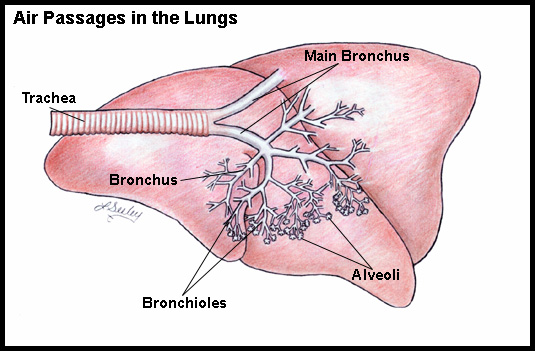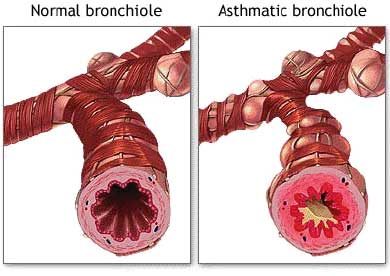We all know people can develop asthma. We also all know an asthma attack can be life-threatening without appropriate medical intervention. What you may not know is our capricious cat friends can also develop this airway disease. This week I share some insight into this important feline malady with a sincere hope of increasing awareness of it. Happy reading!
Asthma in Cats – What is it?
To understand asthma, one must have a basic knowledge of the anatomy of the respiratory system. The respiratory tract is simply a series of tubes that starts at the mouth, becomes progressively narrower, and terminates in multiple small air sacs called alveoli where oxygen is transferred from the lungs to the bloodstream. The windpipe (called the trachea) is a large tube, and is often referred to as part of the upper airway. The bronchi and bronchioles make up the lower airway. The purpose of the upper and lower airways is simple: to bring air in from the environment and transport it to the lungs where oxygen can be transferred to the bloodstream.

Asthma is a disorder of the lower airway that limits proper airflow. A myriad of substances in the environment can irritate the lower airways. Despite this fact, the lower airway has the ability to respond to all of these irritants only in a limited number of ways:
- The lining cells (called epithelium) of the lower airway changes
- Unique cells in the lower airway (called goblet cells) produce a lot of mucus
- The muscle in the lower airway changes

The culmination of these responses is an often marked narrowing of the lower airway due to muscle constriction, swelling of the tubular walls, and/or accumulation of mucus inside these small tubes.
Asthma in Cats – What does it look like?
Like people, mildly affected asthmatic patients may only have intermittent and brief coughing episodes. Furthermore, these cats may not have any clinical signs at all between episodes of lower airway constriction. Conversely, severely affected cats often cough, wheeze, and struggle to breathe on a daily basis. They commonly breathe rapidly and with their mouths open. Some appear to exert more effort to breathe out, and make an often subtle noise during exhalation – this is commonly called an expiratory grunt. Any breed of cat may develop asthma, but Siamese cats are over-represented.

Watch the video below of a cat with compatible clinical signs of asthma:
Asthma in Cats – How is it diagnosed?
To date, there is no definitive diagnostic test to diagnose asthma in cats. Several other diseases may cause similar clinical signs as those observed in asthmatic patients, particularly:
- Lower airway and/or lung infection caused by bacteria and/or fungi
- Heartworm disease
- Lungworm infestation
- Lung tumors
- Congestive heart failure
- Lung lobe torsion
- Non-cardiogenic edema (e.g.: intoxication, electrocution, strangulation)
- Lung hemorrhage
Veterinarians must rely on several factors, most notably a patient’s history, changes on radiographs (x-rays), and a patient’s response to therapies. They will ask you specific questions about your cat’s history, particularly the type and duration of clinical signs. They need to know about any travel you have done with your cat, any exposure s/he has had to other animals, and the environment in which s/he lives (e.g.: indoor only vs. outdoor only vs. indoor/outdoor). Your answers to these important questions, combined with a complete physical examination, help the veterinarian develop a logical diagnostic plan to screen for other diseases that may cause similar clinical signs. Remember asthma in cats is a diagnosis of exclusion. It is important to eliminate from possibility any other reasonable disease process(es) that could mimic the clinical signs of asthma. Partnering with a board-certified veterinary internal medicine specialist can be instrumental for developing a logical and cost-effective diagnostic plan for a suspected asthmatic patient.
Radiographs of the chest cavity of asthmatic cats frequently document changes in the lower airways consistent with thickening of tubular walls of the lower airway. Sometimes an individual lung lobe is collapsed because it hasn’t been adequately aerated due to excess accumulation of mucus. The lungs may also appear over-inflated because asthmatic patients often have difficulty exhaling normally.
Earlier I mentioned asthmatic cats experience marked constriction of their lower airways. Administering a medication to dilate the lower airways (called a bronchodilator) often results in rapid improvement in ease of breathing. Similarly, asthmatic cats benefit from the anti-inflammatory effects of corticosteroids; indeed, failure to positively respond should prompt a veterinarian to reevaluate the diagnosis.
Asthma in Cats – How is it treated?
Treatment of asthma in cats requires both medications and environmental modification. Medically, asthmatic patients initially benefit from two types of medications:
- Bronchodilators (e.g.: albuterol sulfate/salbutamol/Proventil®/Ventolin®; salmeterol xinofoate/Serevent®; terbutaline; aminophylline)
- Corticosteroids (e.g.: fluticasone proprionate/Flovent®/Flixotide®; prednisolone; dexamethasone; triamcinolone; beclomethasone diproprionate/Qvar®)
Bronchodilators relieve the constriction of the lower airways that is classic in this disease. They may be administered either as an injection or via an inhaler. Corticosteroids may similarly be given by mouth, injection, or via inhaler. The use of inhalers in cats is well-tolerated, and studies have repeatedly shown inhalation of medications is an effective route for delivering sufficient doses to be clinically effective. If you are skeptical about a cat tolerating inhaled medications, please watch the video below from a pet parent to see how stress-free inhaler treatment can be!
Environmental cleanliness is important for asthmatic cats. Pet parents are encouraged to use dust-free litters, and one’s residence should be dusted and vacuumed regularly. Use of unscented cleaners, and avoidance of strong perfumes/colognes, incense, and aromatic oils is often helpful. Furnace filters should be changed regularly, and some pet parents report a benefit from using additional stand-alone HEPA air purifiers in their respective households.
As in humans, some feline patients do not respond adequately to initial medications and environmental management. A number of other therapies have been studied in asthmatic cats, and research continues in an effort to find highly effective treatments and even a cure! Evaluation by a board-certified veterinary internal medicine specialist is often helpful for cats who don’t respond to initial interventions as expected.
The take-away message about asthma in cats…
Asthma is cats is similar to its human counterpart, as is characterized by constriction of the lower airway that prevents adequate airflow. Affected patients often cough and wheeze during constrictive episodes, but may appear 100% normal between episodes. Treatment with bronchodilators and corticosteroids typically leads to rapid clinical improvement. As there is no definitive diagnostic test for asthma in cats, a thorough diagnostic investigation is essential. Board-certified veterinary internal medicine specialists are available to partner with pet parents and their family veterinarian to develop logical diagnostic and therapeutic plans for affected cats.
To find a board-certified veterinary internal medicine specialist, please visit the American College of Veterinary Internal Medicine.
Wishing you wet-nosed kisses,
cgb




